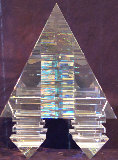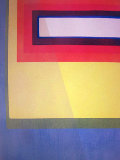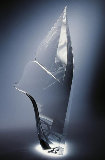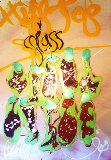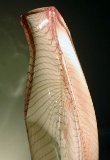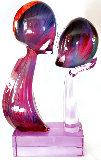-

-
Michael Taylor
United StatesArt Brokerage: Michael Taylor American Glass Artist: Michael Estes Taylor was born in Lewisburg, Tennessee and began to draw at age 12. At age 18 he entered Middle Tennessee University in Murfreesboro where he was awarded a B.S. in art education. He entered graduate school in 1967 at East Tennessee University in Johnson City, where he received a summer scholarship to Penland School of Crafts. There he was first exposed to glass as an artist's medium. He returned to Penland in 1968 and, with the encouragement of glass artist Fritz Dreisbach, began to work with glass. Taylor graduated from East Tennessee University in 1969 with an M.A. in sculpture and ceramics. That summer he studied glass at the University of Utah under University of California-Berkeley instructor Marvin Lipofsky. In the fall Taylor returned to Tusculum College in Greenville, Tennessee, where he was working as a part-time art instructor, to take a full-time teaching position. In 1970 Taylor attended the Toledo Museum School's Glass Workshop, where he met a number of the artists involved in the Studio Glass Movement, including Dominick Labino, Harvey Littleton, Harvey Leafgreen, Jack Schmidt, Doug Johnson, Tom McGlauchlin and Henry Halem. Returning to Tusculum College, Taylor won a Louis Comfort Tiffany grant to work with Harvey Littleton at Littleton's studio in Verona, Wisconsin. In 1977, while serving as the chair of the art department at Peabody College, Taylor returned to graduate school at East Tennessee State University, where he was awarded an M.F.A. in sculpture. Taylor began his career as an artist in ceramics. His earliest series, "Analytical Perspectives" of 1965–66, focused on the vessel format. In the "Libidinous Manifest" series of 1969 Taylor sculpted organic ceramic forms that he placed open-end down on wood pedestals to proclaim their alliance with sculpture. In contradiction to the sensual knobs and bulges of his forms, Taylor painted the sculptures with shiny enamel in eye-popping colors. The addition of hard-edged geometric shapes and stripes painted on the forms further challenged the biomorphic forms while the addition of rayon flocking and in, one case ("Libidinous Manifest #10"), a clinging web of red crocheted yarn placed the works firmly in the era of psychedelic imagery. Also in 1969, Taylor took his first foray into glassblowing. Early works included the "Glass Fabrication" series, in which Taylor combine blown glass forms with grommets, plate glass and automotive products, such as motor oil and anti-freeze. A trip to Scandinavia in 1974 gave Taylor the opportunity to work at the Johansfors Glasbruk in the province of Småland, Sweden where he developed his "Johansfors" series. There he created sculptures by cutting and assembling clear glass forms manufactured by the factory. Upon his return to his Nashville, Tennessee studio Taylor continued his exploration of cut and assembled clear glass forms in his 1975–76 "N-Sequence" series. The artist found that the soda-lime glass that he used to make the forms for this series had impurities in it that caused striations in the glass; these he felt, distracted from the appreciation of the sculptures. In subsequent series of fabricated glass sculptures Taylor created his forms in borosilicate glass, the same substance of which Pyrex laboratory glass is made. His best known body of work is his geometric glass sculptures. He works the glass cold, shaping, polishing and laminating translucent colored and clear blocks of glass together using epoxy resin. Listings wanted by Art Brokerage.
Read More + - Create Listing 0 Artworks for sale 3 Followers
-
We are actively seeking listings for Michael Taylor.
Create a free listing or free wanted ad.






